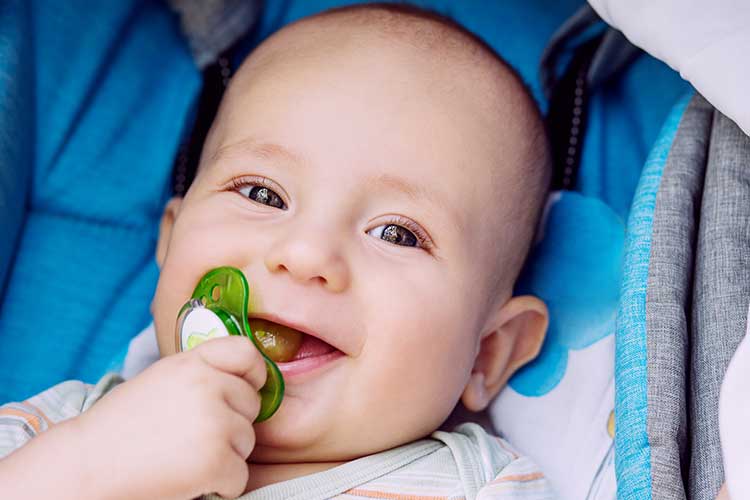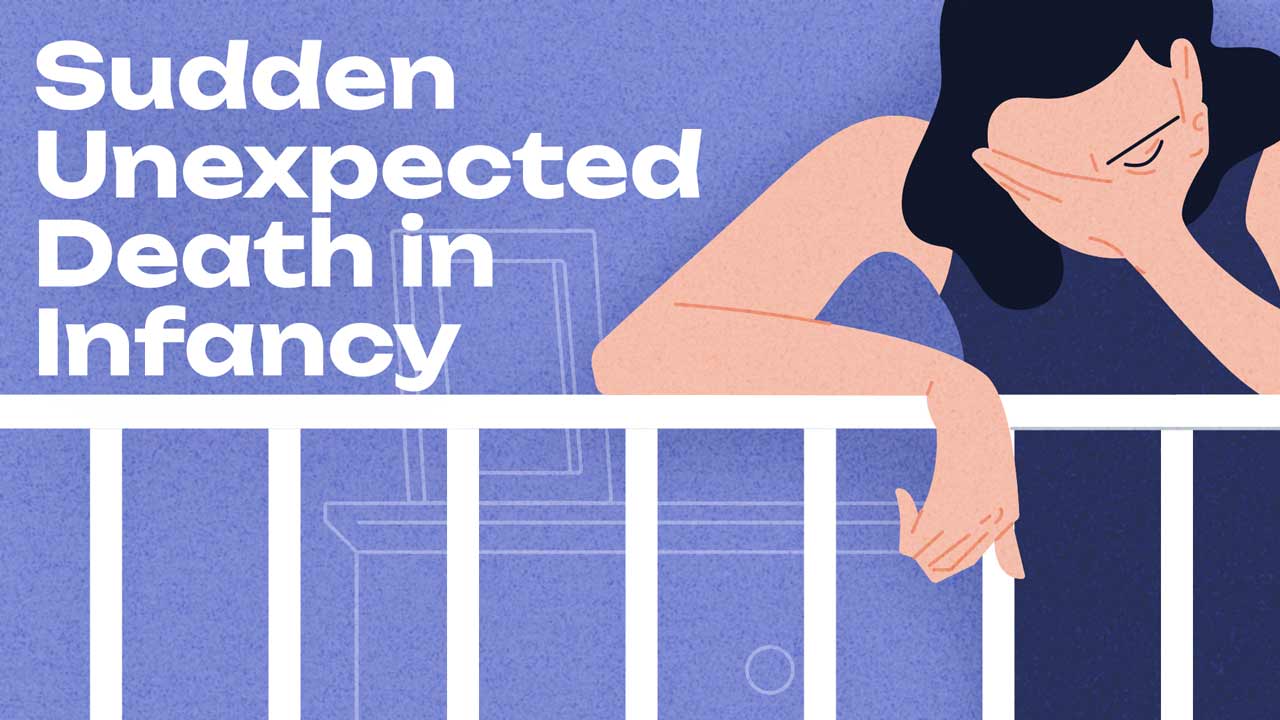Sudden unexpected death in infancy (SUDI) is the sudden and unexpected death of an apparently healthy baby within the first year of life (raisingchildren.net.au 2024a).
SUDI can be categorised as either:
- Fatal sleep accidents caused by the infant being suffocated, trapped or strangled in their sleeping environment
- Underlying medical conditions that were not known prior to the infant’s death
- Sudden infant death syndrome (SIDS) - unexplained deaths with no determined cause.
(raisingchildren.net.au 2024a; Healthdirect 2022)
Although SUDI can occur whilst a baby is awake, most deaths occur whilst the baby is asleep, with a peak incidence between two and four months of age (Better Health Channel 2021).
In Australia, SUDI accounts for approximately 3 deaths out of every 10,000 births (raisingchildren.net.au 2024a).
Predisposing Factors to Sudden Unexpected Death in Infancy
The exact cause of SUDI is unknown, and there are no consistent warning signs that it will occur (Better Health Channel 2021).
All infants are at general risk of SUDI; however, specific risk factors include:
- Exposure to tobacco smoke or drugs in utero or after birth
- Young age (two to four months)
- Unsafe sleep environment
- Premature birth
- Being small at birth
- Underlying complex medical issues.
(Better Health Channel 2021; raisingchildren.net.au 2024a)
The Triple Risk Model
The Triple Risk Model suggests that in order for SUDI to occur, all three of the following conditions must be present at the same time:
- The infant must have an underlying vulnerability that predisposes them to SUDI. It’s unknown what exactly this vulnerability could be, but it’s theorised to involve defects in the parts of the brain that control respiration and heart rate, genetic factors, or a dysfunctional arousal mechanism.
- There also must be an external stressor. For example, asphyxia associated with a prone sleeping position and airway compression or impaired cardio-respiratory regulation related to heat stress.
- These stressors must occur during the critical period of development, i.e. within the first year of life, particularly during the first six months.
(Red Nose 2023)

Safer Sleep Guidance
Although SUDI is not always preventable, particularly in the case of underlying medical problems, providing a safe sleeping environment for the infant is the best way to reduce the risk of death (Healthdirect 2022).
This is because safe sleeping strategies aim to remove as many risk factors for SUDI as possible (Red Nose 2023).
Ever since national awareness was brought to SIDS risk factors in 1991, the rate of SIDS in Australia has decreased dramatically (AIHW 2022).
In fact, since 1990, the incidence of SIDS has decreased by up to 85% (Better Health Channel 2021).
This is why following the safe sleep recommendations for infants is crucial.
Do:
- From birth, always place the baby on their back to sleep, both day and night. This reduces the risk of aspiration and helps to keep the baby's airways clear.
- For the first 6 to 12 months of life, the baby should sleep in a safe cot in the same room as their caregivers - this reduces the risk of SUDI by half.
- Ensure the baby’s cot, mattress and bedding meets Australian standards.
- Ensure the baby’s mattress is firm, flat and clean.
- Make sure the mattress properly fits the cot (so that the baby cannot become wedged between the mattress and the cot).
- Maintain a smoke-free environment.
- Position the baby’s feet at the bottom of the cot.
- Keep the baby's head uncovered with their blanket tucked in on three sides, no higher than chest level.
- If using a safe sleeping bag, ensure that it:
- Is well-fitted across the neck and chest to prevent the baby from slipping inside the bag
- Has sleeves or arm holes so that the baby can move their arms freely
- Does not have a hood or head covering.
(Better Health Channel 2021; raisingchildren.net.au 2024b, c; Healthdirect 2022)
Don’t:
- Don’t sleep the baby on their stomach or side
- Don’t sleep the baby with their face or head covered
- Don’t dress the baby in excessive clothes, hats or beanies to sleep, as this can cause overheating
- Don’t sleep the baby on a soft surface or couch
- Don’t co-sleep (sleep on the same surface as the baby e.g. in the same bed)
- Don’t sleep the baby where they could get wedged between the mattress and cot, or bed and wall
- Don’t sleep the baby with loose or fluffy bedding
- Don’t put any objects in the cot (e.g. pillows, soft toys, cot bumpers) as these can be hazards
- Don’t fall asleep with the baby on a couch or chair
- Don’t sleep with any other children or pets while the baby is sleeping in the same room.
(Better Health Channel 2021; raisingchildren.net.au 2024b, c; Healthdirect 2022)
Do Pacifiers Reduce SIDS?

There is evidence to suggest that the use of pacifiers is associated with a reduced risk of SUDI. However, the reason for this is not completely understood, and this has not been confirmed through a randomised control trial (Red Nose Australia 2018; RCHM 2020).
There are a variety of potential theories as to why pacifiers might reduce the risk of SUDI. These include:
- Sucking on a pacifier keeps the tongue forward, which helps to maintain upper airway patency
- Non-nutrient sucking reduces gastro-oesophageal reflux
- Sucking on a pacifier decreases the arousal threshold
- Infants are calmer when sucking on a pacifier and are, therefore, less likely to move around in their sleep
- Pacifier handles are bulky and may prevent accidental hypoxia from the infant’s head being buried in soft bedding
- Sucking on a pacifier might contribute to the development of neural pathways that control upper airway patency.
(Red Nose 2021)
In Australia, the use of pacifiers is not actively encouraged nor discouraged. It’s up to caregivers to make an informed decision after considering the potential advantages and disadvantages of pacifier use (Red Nose 2021; RCHM 2024).
If a pacifier is used, however, it’s recommended that it be introduced only after breastfeeding has been established and phased out after one year for breastfed infants (Red Nose 2021).
The Psychological Impacts of Sudden Unexpected Death in Infancy
Losing a child suddenly and unexpectedly is a devastating experience that can have a severe psychological impact on the bereaved family. Feelings of guilt, anger, fear, blame and despair are common. Support from family, friends, healthcare professionals, counsellors and/or social workers will be extremely valuable. Some bereaved families may find it helpful to talk to other families who have lost an infant to SUDI (Better Health Channel 2021; raisingchildren.net.au 2024a).
Test Your Knowledge
Question 1 of 3
Which of the following statements is true regarding pacifier use and sudden unexpected death in infancy?
Topics
References
- Australian Institute of Health and Welfare 2022, Infant and Child Deaths, Australian Government, viewed 27 February 2025, https://www.aihw.gov.au/reports/children-youth/australias-children/contents/health/infant-child-deaths
- Better Health Channel 2021, Sudden Unexpected Death in Infants (SUDI and SIDS), Victoria State Government, viewed 27 February 2025, https://www.betterhealth.vic.gov.au/health/healthyliving/sudden-unexpected-death-in-infants-sudi-and-sids
- Healthdirect 2022, Sudden Infant Death Syndrome (SIDS), Australian Government, viewed 27 February 2025, https://www.healthdirect.gov.au/sudden-infant-death-syndrome-sids
- raisingchildren.net.au 2024a, Sudden Unexpected Death In Infancy (SUDI), SIDS And Fatal Sleeping Accidents, Raising Children Network, viewed 27 February 2025, https://raisingchildren.net.au/guides/a-z-health-reference/sudi
- raisingchildren.net.au 2024b, Reducing SUDI and SIDS Risk: In Pictures, Raising Children Network, viewed 27 February 2025, https://raisingchildren.net.au/guides/first-1000-days/development/reducing-sudi-sids-risk
- raisingchildren.net.au 2024c, Sharing a Room with Your Baby, Raising Children Network, viewed 27 February 2025, https://raisingchildren.net.au/babies/sleep/where-your-baby-sleeps/sharing-a-room-with-baby
- Red Nose 2021, Using a Dummy or Pacifier, Red Nose Australia, viewed 27 February 2025, https://rednose.org.au/downloads/RedNose_infostatements_Dummies_June21.pdf
- Red Nose 2023, Why Are Safe Sleeping Recommendations So Important?, Red Nose Australia, viewed 27 February 2025, https://rednose.org.au/article/why-are-safe-sleeping-recommendations-so-important
- The Royal Children's Hospital Melbourne 2024, Safe Sleeping, RCHM, viewed 27 February 2025, https://www.rch.org.au/rchcpg/hospital_clinical_guideline_index/Safe_sleeping/

